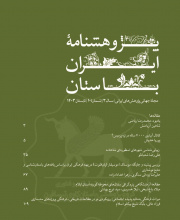۱.
Bashkard is a mountainous hinterland in south-eastern Iran where the two cultural regions -HalīlRūd and Jāzmūriyān-, make it outstanding. In addition to their location, surface finds around the village of Ahven in this county -in particular, the site numbered 044- indicate a chronicle of human settlements and the existence of cultural-trade interactions with HalīlRūd and Jāzmūriyān. The sampled surface potsherds and a few other cultural materials (decorative beads and shells and bronze objects -especially, round and quadrangle stamp seals) there belong to Chalcolithic and Bronze Ages. In terms of the paste colors, the potsherds represent two main groups: orange and gray. The other colors (buff, brown, and reddish gray) are less common. They are decorated with geometrical, plant, and animal motives as well as bold horizontal wavy and straight bands, and incised/scratched lines (perhaps with a sharp item such as a comb); often, one of these techniques and in some cases, both are applied on the potsherds. In terms of form (rim, neck, shoulder, handle, spout, wall/body, pedestal, and bottom) they are classified into commonly used vessels such as bowls, small jugs and jars, tumblers/beakers, and small pots. Exceptionally, a shallow tray and gray pottery of rectangular shape (probably a mold) have been recovered from the surface. Their comparison with well-known southeastern sites shows that Ahven could have predominantly acted as the trade-cultural route of between southeastern establishments and the northern and southern coasts of the Persian Gulf. The author’s archaeological survey of the region is the first attempt to ascertain Chalcolithic and the Bronze Age cultural materials as presented in this article.
۲.
In 1994, it was reported that a group of smugglers had been arrested while excavating the hills of Hossein Abad, south of Susa, about 800m south of an area called Siahchal (Donjon). That excavation led to the revelation of half of a stone coffin or a sarcophagus and eventually led to the discovery of two more sarcophagi, which were located 2.5m from each other. The first sarcophagus was constructed in the form of a tomb with bricks of lion stamp patterns. Both sarcophagi are made of sandstones. The mine of these stones does not appear to have existed in Susa. However, the older fabric of Susa had instances of a sand mass, with underground cellars created inside these stones. Hence, the stones from which the sarcophagi were built could probably relate to Susa. No objects or human skeletal representing burial remnants were recovered from inside of the sarcophagi; however, out of Sarcophagus No. 1, some pieces of earthenware and perfume containers (Alabaster) were found. The bricks used in Tomb No. 1 were bearing lion patterns, as the pieces of earthenware and marble perfume bottles, numerous examples of which were reported from there, demonstrate they could reasonably be attributed to the Achaemenid dynasty.
۳.
Bullas are usually a bit of inscribed clay in different shapes and sizes that were made to stamp out goods. They were applied at a time when bullas were still soft and wet so that the owners of the goods could stamp them depending on their necessity and importance. Sealing imprints could be seen on bullas, with each bearing images, symbols, and inscriptions indicating or in possession of someone authorized to stamp on respective products. The discovery of these cultural materials during archaeological surveys brought to the fore the economic, cultural, religious, and political activities of the region in ancient times. Further study and research in this field can respond to many ambiguities and historical questions. The current paper is based on field surveys and library materials and aims to introduce, study, and compare Tal-i Gerdooha clay bullas discovered in Eqlid County. Based on images and inscriptions, bullas scrolls were divided into two groups and potentially belonged to the Sasanian period.
۴.
The site of Khum Zargar is located in the area of Hesa Awal Kohistan town in Kapisa province, north of Afghanistan, and south of the Hindu Kush Mountain range. It is closer to Jabul Saraj textile factory and Golbahar town, 60 km north of the Afghan capital Kabul. Archaeological excavations were carried out in several seasons in 1966, 2019, and 2020 by an independent team of Afghan archaeologists that resulted in the discovery of a Buddhist ritual complex with several stupas and adjacent rooms. In addition, human and animal statues and pottery objects were found in these rooms. Undoubtedly, the findings played an important role in ascertaining the history of Buddhist art and architecture during the Kushan and Kushano-Sasanian periods in the south of the Hindu Kush, and the present article discusses this site and its works.
۵.
The Parthian Empire was a major Iranian political and cultural power in ancient times and reigned in Iran for almost 500 years. There have been many books or articles written on Parthians over the past years; however, in recent years, research on this empire has intensified. The Parthians: The Forgotten Empire by Uwe Ellerbrook, was published in 2021. In this book, Ellerbrook has investigated all aspects of the Parthian kingdom and goes beyond the political history of the Parthians to familiarize the readership with the archaeology, history, culture, religion, art, and society of the Parthians.
۶.
The Sasanian era is one of the important periods of Iranian history and archeologists and historians have come up with many books and articles on this period. Sasanian Persia, Between Rome and the Steppes of Eurasia, is a new book that also includes articles in this regard, edited by Eberhard W. Sauer and published by the University of Edinburgh Press.
